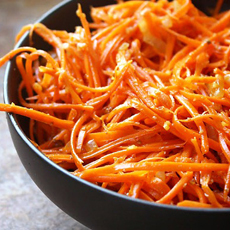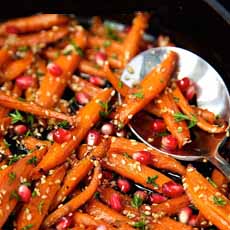|
What’s up, Doc?
The humble carrot, dressed to impress.
Winter, with its paucity of produce choices, is the best time to enjoy root vegetables. The most familiar—and the easiest to convince family members to eat—is the carrot. Here, some ideas from the familiar to the less so. Below:
> The history of carrots.
> How carrots became orange (they were originally white).
> Carrot salad recipes.
> January is National Carrot Month. April 4th is International Carrot Day.
> February 3rd is National Carrot Cake Day.
> April 30th is National Bugs Bunny Day. September 28th is International Rabbit Day.
A BRIEF INTRODUCTION TO ROOT VEGETABLES
Root vegetables most common in the U.S. include the beet, carrot, celery root (celeriac), Jerusalem artichoke, garlic, kohlrabi, onions (use baby onions), parsnips, potato (use small waxy potatoes), radishes, rutabaga, salsify, and turnip.
Root vegetables are high in vitamins and minerals, which they absorb from the ground. Many are high in vitamin A, B complex and C; plus antioxidants. Root vegetables are an excellent source of fiber.
Many of these can be eaten raw, steamed, sautéed, baked, roasted, stir fried, or fried.
In the case of carrots, Whether baby, heirloom or standard, carrots and their root kin are waiting at your nearest market.
COOKING CARROTS
Beyond boiled carrots, carrot salad and crudités, consider these preparations:
Brochette: Parboil and skewer them, then grill them and serve as a fun brochette.
Classic: Steam them and toss in butter with fresh dill or parsley.
Gratinée: Roast or steam, top with shredded Gruyere or other cheese and broil until melted.
Fancy cut: Cooked the carrots shredded, as you wood a slaw; or use mini vegetable cutters to make small flowers and other shapes.
Roasted/Grilled: Roast them in garlic butter and garnish with chopped parsley.
Pan-fried: We just tried this for the first time. Here’s a recipe.
Pickles: Pickle carrots as you would cucumbers or any vegetables. You can quick-pickle in just an hour.
Purée: A terrific way to eat most dense vegetables.
Raw: as crudites or grated into a slaw/mixed slaw, or mixed into a salad. Just grate them or slice thinly. Beyond carrots, think beets and radishes. Anything sold fresh with the greens attached—kohlrabi, turnips—will be moist, sweet and of course, crunchy, when raw. While not sold with its greens, rutabaga is mild and often sweet. Although drier than turnips or kohlrabi, it contributes a pale yellow color to the mix.*
Soup: When was the last time you made soup? Carrot soup is a perennial favorite. Make it chunky—like a thin purée. Garnish with fresh herbs and, as desired, a slice of bacon or sausage.
Sandwich:
Different choices here: Roasted carrot or mixed roasted vegetable sandwich, with or without goat cheese; or carrot pickles or carrot slaw on a ham, turkey or other sandwich.
Stew: For Meatless Mondays, try this hearty Carrot-Mushroom-Barley Stew from Food Network.
WAYS TO TREAT ANY CARROT PREPARATION
Blended: Combine with other root vegetables†: beet, celery root (celeriac), Jerusalem artichoke, garlic, kohlrabi, onions (use baby onions), parsnips, potato (use small waxy potatoes), radishes, rutabaga, salsify, turnip, etc.
Garnishes: Beyond herbs, consider toasted breadcrumbs, pecans, raisins, seeds or a mix. For color, try dried cranberries, dice red bell pepper or pomegranate arils. Rings of red jalapeño with the seeds and pith remove also work. Those who don’t like heat can set them aside.
Heat: Add your choice of heat—cayenne, chile flakes, hot sauce, etc.—to the dish.
Herbs: Basil, dill, marjoram, oregano, parsley, rosemary and thyme are naturals with carrots.
International: From Indian to Moroccan, French to Japanese, your favorite international flavors work with carrots.
Spices: “Fall” spices such as allspice, cloves, cinnamon, ginger and nutmeg are delicious with carrots. Also try coriander.
Sweet: Add a bit of brown sugar, honey or maple syrup.
Do you have a favorite carrot preparation?
If it’s not listed here, please let us know!
|
|

[1] “Cooked” carrot salad. Here’s the recipe from Walnut Frog.

[2] Carrots with other root vegetables (here, radishes and baby onions). Here’s the recipe, with a maple-honey glaze, from Kalamazoo Gourmet.

[3] Pan-fried carrots with parsley. Not the red skin: It’s an heirloom variety. Here’s the recipe from The Nourishing Gourmet.

[4] These glazed carrots are accented with sesame seeds and pomegranate arils for more color. Here’s the recipe from The Café Sucre Farine.

[5] Grilled carrot sandwich on crusty bread with goat cheese, apricot jam and toasted pine nuts, at The Wayfarer | NYC.

[6] This picture is not Photoshopped: These are natural mutations. See how it happens, below (photo courtesy The Wayfarer).
|
CARROT HISTORY
The original wild carrots were white, like parsnips. According to Colorful Harvest, marketer of rainbow carrots, the cultivated purple and yellow carrots—mutations—were eaten more than 1,000 years ago in what is now Afghanistan.
Other colors are the product of generations of traditional plant breeding. Orange carrots were first successfully bred in Holland from an orange mutation by Dutch farmers. Here’s the history of carrots.
FROM WHERE DO CARROTS GET THEIR COLOR?
Deeply colored produce are rich in nutrients, including antioxidants. Different antioxidants produce the different colors or carrots:
Red carrots get their color from lycopene, an antioxidant that may promote healthy eyes and a healthy prostate.
Orange and tangerine carrots get their color comes from beta-carotene, an antioxidant and precursor of vitamin A.
Purple carrots get their color from anthocyanins, the same potent phytonutrients (antioxidants) that makes blueberries blue,. Anthocyanins are flavonoids that may help increase the antioxidant capacity of the blood and may help maintain good brain function.
Yellow and white carrots get their color from lutein, which studies suggest may promote good eye health.
________________
*Tenderness, moistness and delicacy depend in part on how and where a vegetable is grown. Those grown in a hot, dry climate without sufficient irrigation can turn out to be pretty hot and spicy. If you end up with that character, you can reduce the spiciness by blanching the cut pieces in salted, boiling water. (Source)
†Other common root vegetables, that don’t necessarily lend themselves to these preparations, include include daikon, ginger, horseradish, jicama and turmeric.
CHECK OUT WHAT’S HAPPENING ON OUR HOME PAGE, THENIBBLE.COM.
|








